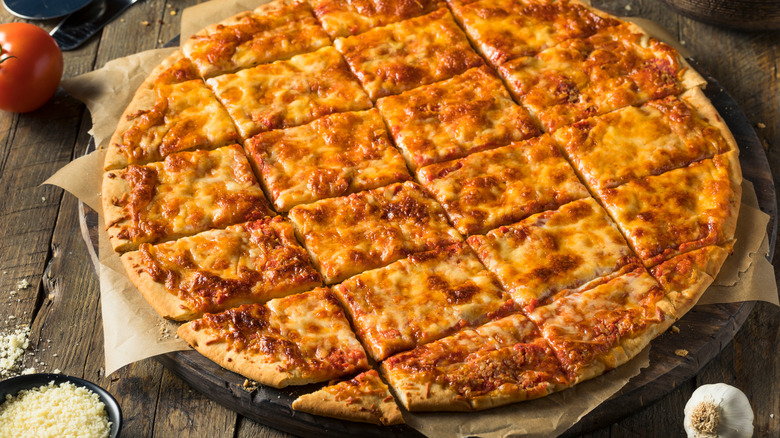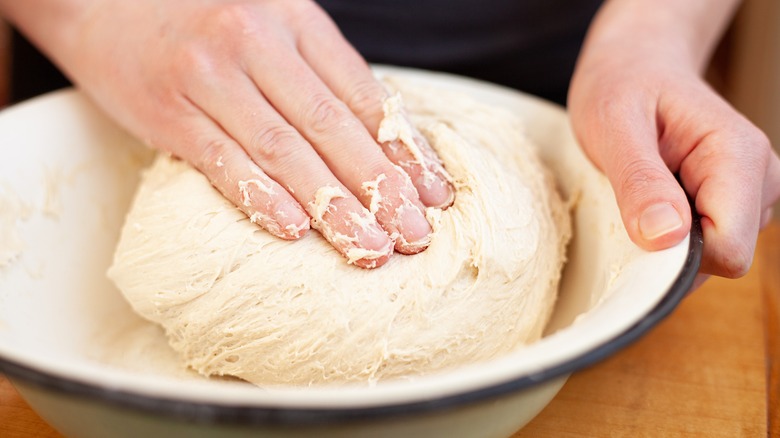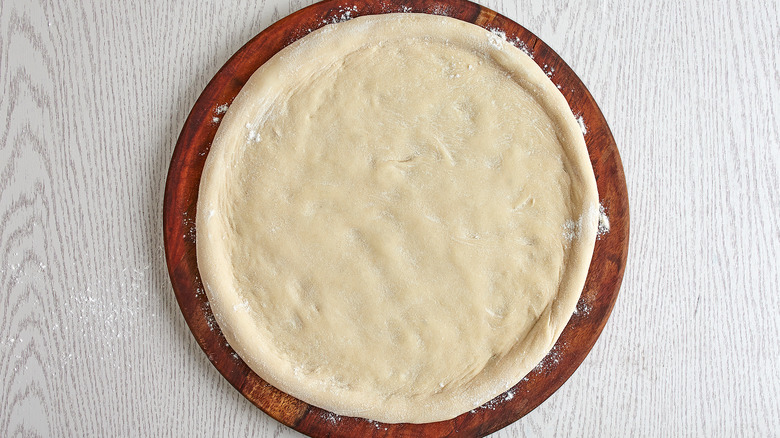Here's How Long To Ferment Pizza Crust For The Crispiest Possible Results
People who love pizza have strong opinions about pizza. There are as many definitive points to be made as there are the people who hold them — obviously, some are wrong. And regardless of what you think of Midwestern bar pizza, it has some rules, as Jason Diamond explains in a party-cut pizza think piece for Bon Appétit: It must, of course, be "A circular pie with really thin crust, all cut into tiny squares." But above all, the crust must be cracker crisp.
J. Kenji López-Alt is known for his deep dives into ingredients and techniques to really perfect a recipe, so it's no surprise that he spent five months studying Chicago thin-crust pizza or that he wrote over 2,000 words on it for The New York Times. He learned that in order to make a perfect Chicago thin-crust pizza, you must throw out every rule you've ever learned about making great bread. Hydration is the enemy, and there is no such thing as over-proofing. A springy rise isn't welcome, and as far as fermentation time goes, the sky's the limit.
Fermenting dough is the process by which you leave the dough to sit and rise — this is how it develops complex flavor and texture. Usually, this process takes no longer than 48 hours; at a certain point, fermentation starts deteriorating the structure of your bread by weakening the gluten bonds. It's terrible for bread, but great for this pizza: You'll need three to five days.
The science that crisps the crust
What J. Kenji López-Alt discovered is that an over-hydrated dough that is fermented for a standard length of time will be crisp, but still flexible and tough — and Chicago thin crust pizza must be as crispy as possible. It's the only way you'd be able to dip a two-bite piece of interior cut pizza into ranch dressing, after all. Over-fermenting your dough will help, but there are two important factors when actually making your dough to assist in crisping: more fat and less water. To further restrict gluten development, add fat to the dough. Gluten is a protein strand that provides structure by tangling together, but fat interrupts this bond. López-Alt's crusts went from crisp but flexible and tough to shatteringly crunchy with the addition of some oil; he added 10% to 15% oil by weight.
In bread baking, everything is done as ratios of each other in weight. For the sake of ease, let's say your dough uses 100 grams of flour. Hydration is the amount of water you use to create the dough; certain artisan doughs like ciabatta use hydration levels as high as 110% (110 grams of water) to create a big, open, airy crumb and moist interior. Obviously, we don't want this here – you're looking for 56% or under. López-Alt found that any lower than 50% was too hard to roll out, but he found another unusual Chicago trick to dry out the dough even further.
Dry out your crust overnight
A rolled out, un-topped (naked) pizza dough is called a "skin." By rolling out the skin and leaving it for 12-24 hours to air dry in the fridge, the hydration of the dough drops to an estimated 25% to 33%. This process is called "curing," and for the crispiest thin crust pizza, you need to cure your pizza skins. The lower hydration makes the skins leathery, and they form little crunchy bubbles in the oven. You can pick them up and toss them around. It's weird, but it works.
Keep in mind that you won't be able to roll it out any further after this process without ripping the dough, so make sure to roll it to the correct size for toppings before leaving it to cure. This process has the side effect of making it easier to slide the pizzas on and off a peel, which is good news — since a Chicago-style thin-crust pizza is sauced to the edges and heavily topped, the whole thing would make a great big mess getting into the oven if it didn't move with ease.
Once you've made your crispy thin crust pizza make sure, of course, to cut it into party squares and share. Or, if you can't wait a week for your pizza dough, you can hop over to one of Chicago's best pizzerias.


